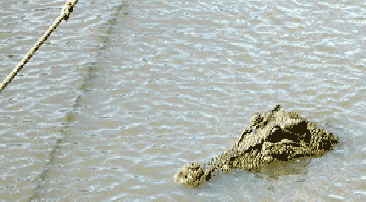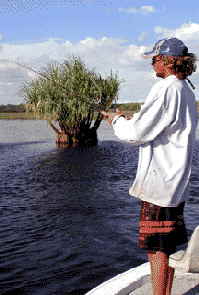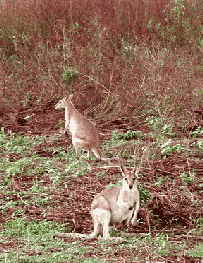|
It's The Outback, Jack!
Australia's Northern Territory Offers Great Fishing And Adventure!
by Larry Larsen
Ever try to battle a feisty 13-pound barramundi while a 2,000-pound crocodile watches you from 10-feet away? There are not many places in the world where you can do that.
 I was in the Northern Territory of Australia's Outback when I was confronted by the paradox. Let the fish swim away or try to land it before the croc exploded
on it just a few feet from our boat? I chose the latter. I was in the Northern Territory of Australia's Outback when I was confronted by the paradox. Let the fish swim away or try to land it before the croc exploded
on it just a few feet from our boat? I chose the latter.
A fat barramundi thrashing at the surface just off the gunwale is an attraction that the giant toothy critters that control the Mary River waterway can't resist.
The 16-foot long black saltwater croc glided up to our boat as I let the fish swim away. After 10 minutes, the reptile moved away and I was able to quickly
land the fish. My guide, Paul Massey, quickly started the outboard and we moved away from the imminent danger.
That monstrous croc, almost 3-foot wide across its back, was only one of about 15 that stalked us while we
fished the muddy tidal river which borders the Kakadu National Park at the Top End of the island continent.
Each time we hooked a fish and got it near the boat, we would look up to see approaching crocodiles. We were
fishing one of the prime spots on the Mary, the Narrows section, which is located some 3 miles downstream from the Shady Camp boat ramp and weir and about 20 miles above the Chambers Bay.
The Shady Camp park and launch ramps are part of the Mary River system which includes both freshwater and
saltwater areas. A weir or "barrage" is set across the river to prevent saltwater from moving further upstream
on an incoming tide, but there is a boat ramp on each side of the barrage. Shady Camp is surrounded by floodplains, and barramundi breed on the floodplains in freshwater.
Timing The Trip and The Bite
 During the prime months of March, April and May, the river falls and gets cooler. The water temperature will start off in the 80s and drop into the
upper 60's by mid-May. When the water is dropping, the fish are shallower. Then when the water is rising, the barra are found in the
deeper spots. Also, when the water is warmer, the experts use smaller lures than they do when waters cool. Warm waters mean active fish that
will feed often. Cooler waters cause the barra to feed less, but on bigger baits that allows them to conserve energy. During the prime months of March, April and May, the river falls and gets cooler. The water temperature will start off in the 80s and drop into the
upper 60's by mid-May. When the water is dropping, the fish are shallower. Then when the water is rising, the barra are found in the
deeper spots. Also, when the water is warmer, the experts use smaller lures than they do when waters cool. Warm waters mean active fish that
will feed often. Cooler waters cause the barra to feed less, but on bigger baits that allows them to conserve energy.
In March, Paul often runs by boat early in the day, two and one-half hours downstream from the Shady Camp ramp to the prime fishing waters along
the coast (and those away from an armada of "runoff" fishermen). Later on waters get rougher downstream, but waters near the ramp can be
crowded with boats. There are 100 boats at the boat ramp most days in March.
Too, the further away he travels, the more fish he and his clients catch usually. Exactly where he goes depends
on the rainfall that each watershed receives in the wet season. Some rivers get more rain. For example, the
nearby Wildman River drainage gets less rain than does the Mary River, so the fishing it the former will be better earlier in the season.
From mid-May through July (their winter), most of the better fishing is in the billabongs. After that, the "build
up" (to the wet season) occurs when things in the tidal rivers get active again. The waters are warming up in
their springtime (October) and the bigger fish are starting to move back up the rivers then. From December though February (Australia's summer), the fishing slows due to the high water.
Giant Barras To Dream About
"The biggest barra and the best numbers are often taken in the three months following the wet season when
the runoff has peaked," says Paul. "Between March 1st and the second week in May, my anglers have caught
38 barramundi over one meter (39.37 inches). The largest was almost 50 inches. A 44 inch long fish might mean
a fish of 30 pounds one day or one of 40 pounds on another depending on where the fish had been for the previous 3 months and what it had been feeding on."
"The fattest ones have been up in the freshwater feeding in floodplain," he explained. "The lighter fish are
usually those just moving up from the saltwater and have been confronted by constant tidal currents. They're lean, mean, fighting machines basically!"
 Paul's largest barra was a 65-pounder caught near the mouth of the Mary River in March of 2001. The guide actually saw the fish in just 3-feet of water with its
back above the surface and cast to it. Paul's largest barra was a 65-pounder caught near the mouth of the Mary River in March of 2001. The guide actually saw the fish in just 3-feet of water with its
back above the surface and cast to it.
Giant fish sometime congregate nearby on the mangrove flats around the mouths of the tiny bay rivers from 10 to 30 feet wide right at the end of the wet
season. His client's top day for numbers was when 3 anglers caught 197 barra below a broken mud weir. That outstanding day also was very early in the season near the mouth of the Mary River.
Where To Look & What To Throw
Paul likes to throw diving minnowbaits and surface lures in tannin-stained water that sport natural, subdued colors, such as gray, brown, white, green,
and black. In muddy waters, he opts for lures that have internal rattles and those that vibrate greatly as they roll through the water, in order to appeal to the barra's sense of hearing.
"The fish are often on or near the bottom but will move up depending on bait and tidal movements," says the guide. "As a result we have to put lures out at
the various depths until we find out where the fish are holding relative to the normal dropoff along the river's channel."
At the junction of the river and a tributary with a large floodplain above it, there is often an eddy formed when
the tide is coming in and the water is still moving out of the floodplain. Paul will be anchored in such areas
because the bait should be congregated there making for a barramundi "feeding station," as the guide calls them. If a mud bar with a dropoff exists, then casts should be to it.
"Barra will sit at the edge of the bar and then move up on it to feed on the baitfish that are being pushed up on
the shallow bar," says Paul. "Then, they will drop back down into the deeper water. The barra will be
concentrated at these spots and others where the baitfish are sucked out into eddies near the main channel,
 but when the water gets too low, the fish will head downstream." but when the water gets too low, the fish will head downstream."
Guide Experience
Fishing in the tidal creeks and the freshwater billabongs above dams or saltwater intrusion weirs, called barrages, is often excellent in the NT, but you
need a top guide, like Paul. A guide on the river for 10 years, he knows the water. With some 180 days each year guiding over 400 barramundi fishermen, Paul's knowledge is without peer.
The former commercial fisherman from Queensland caught his first barramundi some 11 years ago in the Darwin area and decided to stay and open his own
sportfishing guide business. Paul's daily guide service rate is $275 Australian per person (2 minimum) or $550 per person, which includes accommodations
and all meals. Paul picked us up at our Darwin hotel, the MGM Grand, and we motored some two hours in his 4-wheel drive to the Point Stuart Wilderness
Lodge where we dropped off our bags and headed for the nearby ramp to launch his 16.5-foot boat.
Paul's main fishing "tool" as he calls it is a 2001 model Quintex boat that is a fairly typical rig for those fishing
such waters in the Top End of Australia. The aluminum, modified-V hull with deep draft and plenty of room
between the gunwales has a 90-hp Honda four-stroke outboard strapped to the stern. There are several built
-in underfloor storage boxes and three comfortable seats for anglers wanting to sit in the stable craft while fishing the barra.
"As a tool, maintenance is vital in maintaining its function, so I spend a lot of time taking care of it," explains Paul.
The wilds of the NT are ever-present. Snakes including the aggressive taipan, birdlife, such as jabaru, ibis,
eagles, egrets, brolga (a bird that is the NT symbol and makes the same sound as a didgeridoo – the aboriginal
instrument) and wild buffalo are often seen. A dingo (wild dog), and wallabies (or small kangaroos) are also
present. My target was the barramundi, and fortunately, it is abundant in the Northern Territory. In fact, there is no better barra fishing than that found on Australia's top End!
|
Contact Information
For reservations and more information on the Run-Off Barramundi fishing safaris, contact booking agent HotSpot
Fishing Tours, PO Box 571, Howard Springs, Northern Territory 0835 Australia or phone 1-800-809-035; email at enquiries@hotspot.com.au or visit their website at
www.hotspot.com.au. Paul Massy at Paul's Sportsfishing Safaris can be reached at email paulsbarra@hotmail.com or phone 0419-721-996. Info on Point Stuart Wilderness Lodge,
which lies right in the heart of the great Mary River barra fishing, is available at 08-8978-8914. Info on the MGM Grand Hotel and Casino in Darwin is available at
08-8943-8888 or on their website at www.mgmgrand.com.au.
Qantas Airways do a great job of transporting you to the land down under. The flights are long but the
entertainment options are outstanding and their "Skybeds" in Business Class are very comfortable. They offer codeshare connections (with American Airlines) from several
major airports in the US. For more information or reservations, contact 800-227-4500 or visit their website at www.QantasUSA.com. For general tourism/fishing information
on the Australia's Outback Northern Territory, contact the Northern Territory Tourist Commission at their three websites, www.insidetheoutback.com,
www.fishingtheterritory.com or www.ntholidays.com.
|
|
|